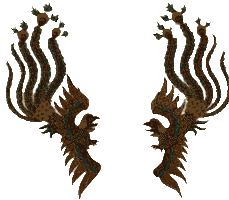Competition Maneuvers of Keluarga Pencak Silat Nusantara (II)
Rapid Journal, Vol. 7, No. 2 (Book 24, 2002: 42-43)
© O'ong Maryono
www.kpsnusantara.com
Demonstrated by Miftah Laewae, trainer KPS Nusantara Ramkamhaeng University (Bangkok, Thailand)
 |
 |
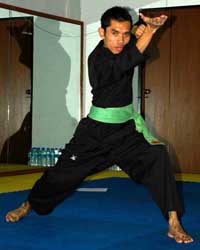 |
||||
fig. 1 |
fig. 2 |
fig. 3 | ||||
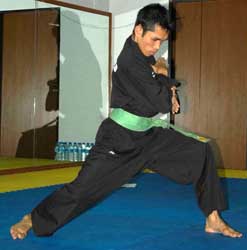 |
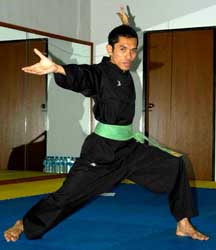 |
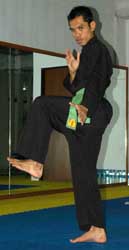 |
 |
fig 4 |
fig 5 |
fig 6 |
fig 7 |
Continuing the description of competition maneuvers (jurus pertandingari) initiated in the previous edition, here I will examine the second sequel (jurus pertandingan II}.
Defense & Attack Tactics
Standing by position (siap) Standing Position XII (sikap dua belas) This standing position signals that the pesilat is ready to fight. From this position the pesilat enters into action by slowly opening the left palm, coming closer to the opponent and winding down the body, slowly moving to standing position I (figs. 1-3). Standing Position I (sikap satu)This position allows a pesilat to carry out sudden attacks. While standing he/she waits for attacks from the opponent. Gradually the pesilat moves closer to the opponent, stepping forward with the right leg, and at the same time going down with the elbow to protect from an eventual attack from the opponent. Slowly, the hands open up to appear vulnerable to attacks (sikap empat) (figs. 4-5).The pesilat uses trickery to take distance from the opponent while targeting him/her with a swerve of the left leg (fig. 6). If this attack fails, the pesilat makes a half jump with the right leg and at the same time front kick with the left leg (fig. 7). After the right leg lands, it is the right leg that steps forward fast, attacking with double hand strikes (fig. 8). In closure, the striking pesilat steps back two times, turns into a flying eagle standing position (elang melayang. fig. 9) and goes back to the stand-by position (sikap slap. fig. 10) in preparation for the next pattern of movements to be discussed in the next issue.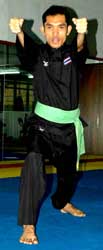 |
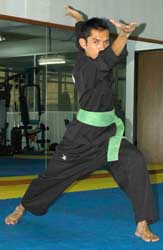 |
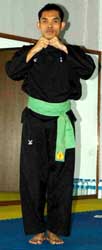 |
fig 8 |
fig 9 |
fig 10 |
